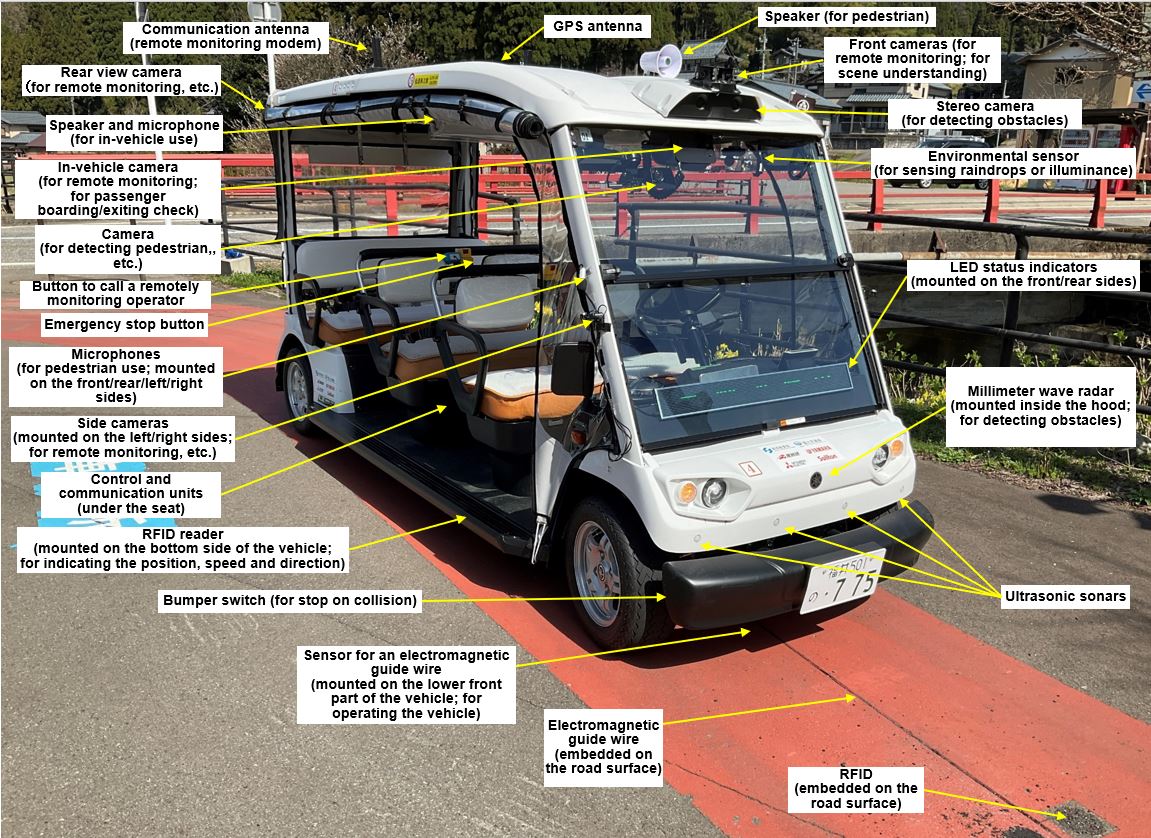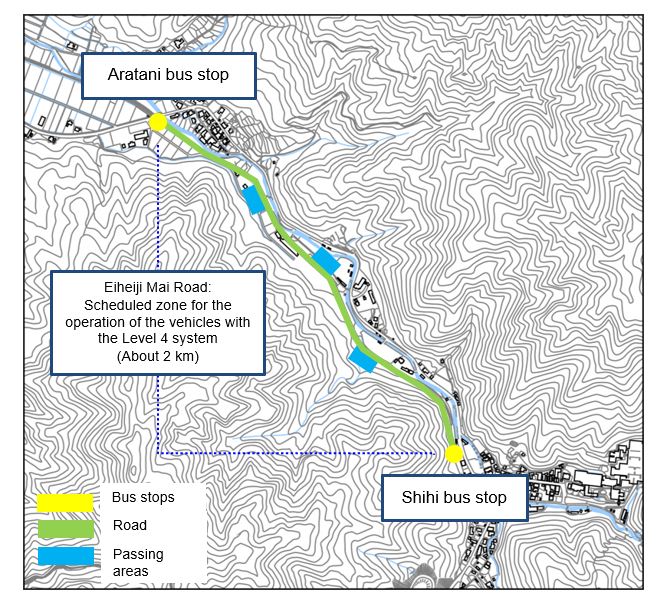- Home
- News Releases
- Back Issues
- May FY2023
- Operation of Automated Driving Vehicle with a Level 4 System Approved for the First Time in Japan
Operation of Automated Driving Vehicle with a Level 4 System Approved for the First Time in Japan
May 12, 2023
Joint Press Release with the Ministry of Land, Infrastructure, Transport and Tourism
As part of the Project on Research, Development, Demonstration and Deployment (RDD&D) of Automated Driving toward Level 4 and its Enhanced Mobility Services (hereinafter referred to as the “RoAD to L4” project), the Ministry of Economy, Trade and Industry (METI) and the Ministry of Land, Infrastructure, Transport and Tourism (MLIT) have jointly been advancing a series of validation tests to achieve automated driving mobility services since FY2021. METI hereby announces that on May 11, 2023, specified automated driving operation under the Road Traffic Act—which is part of the validation test of automated driving vehicles conducted in Eiheiji Town, Fukui Prefecture—was approved for the first time in Japan.
1. Overview
METI and MLIT have jointly been advancing the RoAD to L4 project since FY2021, and as part of the project, the ministries have been advancing a series of validation tests to achieve automated driving mobility services. METI hereby announces that on May 11, 2023, specified automated driving operation under the Road Traffic Act—which is part of the validation test of automated driving vehicles conducted in Eiheiji Town, Fukui Prefecture—was approved for the first time in Japan.
This approval permits vehicles with an automated operation Level 4 system*1 to be operated with no driver.
*1. The term “Level 4” refers to a state in which an automated operation system works as an alternative to the entire driving operation in a limited area that meets specific conditions as a driving environment.
2. Background
Japan’s Grand Design and Action Plan for a New Form of Capitalism and Follow-ups (June 7, 2022) upholds a goal of starting automated driving mobility services operated only by remote monitoring, taking advantage of abandoned railroad sites and other areas, around FY2022. As an effort to achieve this goal, METI and MLIT have been advancing the RoAD to L4 project.
Specifically, the ministries have commissioned part of the project, i.e., Theme 1: Initiative for Achieving Automated Driving Services only by Remote Monitoring (Level 4), to a consortium consisting of the National Institute of Advanced Industrial Science and Technology (hereinafter referred to as “AIST”) and a group of private entities (Soliton Systems K.K., Mitsubishi Electric Corporation and Yamaha Motor Co., Ltd.). The ministries have been advancing a series of validation tests of technologies and services involving automated driving vehicles with a remote-monitoring automated driving system in Eiheiji Town, Fukui Prefecture.
On March 30, 2023, the automated operation Level 4 system was approved for the first time in Japan. Following this, Machidukuri ZEN Connect Inc. submitted a request for approval of specified automated driving operation under the Road Traffic Act to the Public Safety Commission of Fukui Prefecture, and in response, on May 11, 2023, the specified automated driving operation was approved for the first time in Japan.
The consortium will conduct some validation tests concerning the technologies and services configured with a Level 4 system, and following this, they will aim to start automated driving mobility services configured with a Level 4 system in Eiheiji Town, Fukui Prefecture.*2
*2. On May 21, 2023, a commendation ceremony is scheduled to be held to celebrate the start of the automated driving mobility services configured with a Level 4 system.
3. Outline of the approved plan for specified automated driving operation
(1) Vehicles to be used
The following is an outline of the vehicles to be used during the specified automated driving operation.
- Four 7-seater standard motor vehicles with specific driving environment conditions imposed
- The original vehicle as a base of the approved vehicles is the AR-07: Green Slow Mobility developed by Yamaha Motor Co., Ltd., which is an electric cart with a specification tailored to public roads.
- Three vehicles will be used along a predetermined route during the specified automated driving operation, in addition to another vehicle as a backup vehicle.

(Photo provided by AIST)
(2) Driving environment conditions imposed on the automated operation system
The following are the driving environment conditions imposed on the automated operation system which will be used during the specified automated driving operation.
[ⅰ] Road and geographical situations
Road zones:
- Eiheiji Mai Road in Yoshida County, Fukui Prefecture: Abandoned railroad sites along the Eiheiji Line run by Keifuku Electric Railroad Co., Ltd.
- Partial zone of the southern area of Eiheiji Mai Road: About two kilometers between Aratani and Shihi (area before the gate of Eiheiji Temple), Eiheji Town
- Road environment:
- Driving routes making use of an electromagnetic guide wire and RFID
[ⅱ] Environmental conditions
Weather situation:
- The weather should not involve bad conditions such as heavy rain, snowfall, dense fog, or nighttime where the vehicles will not be able to detect pedestrians around them.
Traffic situation:
- No emergency vehicles should be present on the routes.
[ⅲ] Driving conditions
Speed of the vehicles:
- The driving speed generated by the automated operation system of the vehicles should be 12 km/h or less.
Driving situation of the vehicles:
- The vehicles should run on electromagnetic guide wires with magnetism to an extent detectable by the vehicles.
- Road surfaces should not be in unstable conditions, such as being frozen.
(3) Route for the specified automated driving operation
As a route for the specified automated driving operation, about two kilometers in the southern area of Eiheiji Mai Road (area near Daihonzan Eiheiji Temple) will be used.

Division in Charge
ITS and Autonomous Driving Promotion Office, Automobile Division, Manufacturing Industries Bureau